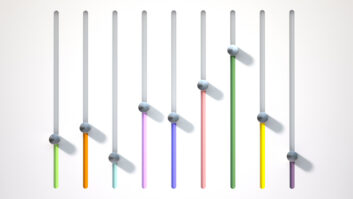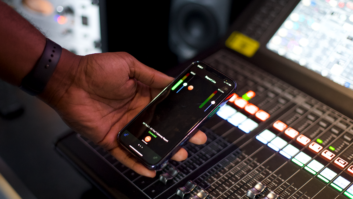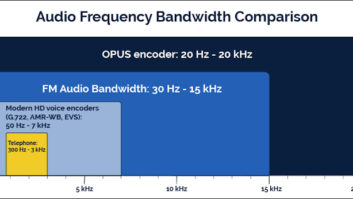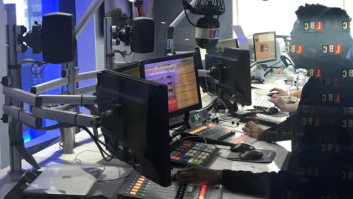Trends in Technology: Recording Sound
Oct 1, 2001 12:00 PM, By Steve Fluker

Capturing the aural moment, while leaving the past behind, couldn’t be easier.
If you have a storage room full of old cart machines, portable cassette decks for news, and reel-to-reel machines collecting dust, you are not alone. Seasoned broadcasters may find it difficult to let go of the past, but welcome the new choices of the digital recording machines on the market today, which have replaced their old analog counterparts. Digital technology is changing on a daily basis, bringing out new ways to record audio using better and smaller devices. Unfortunately, new recorders mean new formats and new storage media. Standardization across the business is fading. Each recording house, voice talent, home studio, and advertising agency has a favorite format to record in and assumes that the broadcaster will have a compatible machine to play it on. Production directors can find themselves scrambling for a way to play back a spot mailed to them.
When outfitting a production room, it’s important to have all of the major types of audio recorders and players. Yes, you should still have an open reel machine somewhere in the facility just in case an agency sends out a spot on tape, and to play those stacks of old tapes on the shelves. You should also keep a cassette deck in the studio as well. Many times a client will still ask for a dub of their spot on cassette to review and keep. Prospective announcers may also send their air check tapes on cassette still.
Understanding digital recorders
When looking at digital recorders, there are a few key terms with which you should be familiar: sample rate, bit rate, and data compression. Basically, a digital recorder is taking repeated pictures or snapshots of what the audio looks like. Like a movie, if you have a large number of pictures taken in a short period of time, and then flip through them, you will see the picture move. Similarly, if you take multiple snapshots of the audio waveforms and play them back rapidly, you will be able to recreate the audio. The sample rate refers to the number of these snapshots taken of the audio every second. CDs, for example, sample at 44.1kHz, or take 44,100 pictures per second. Like a movie, the more pictures you take (the higher the sample rate), the better the quality will be.
Figure 1. The blue line represents the original waveform, the Xs represent the sample points, and the green line represents the reproduction of the digitally sampled waveform. This example shows a 32-bit resolution and a sample rate of 20 samples per second. (Click image for larger view.)

What the recorder is measuring at each sample point is the voltage or amplitude of the audio waveform. The resolution and sample rate refer to how accurately that measurement is taken. Just like with digital cameras, the higher the resolution or sample rate, the better the quality. Figure 1 shows an audio sample with a 32-bit resolution and a sample rate of 20 samples per second. CDs are recorded with 16 bits, which translates to a resolution of 65,536. A 24-bit rate audio expands that resolution to 16,777,216.
The third important term to understand is data compression. Digital recorders have a limited amount of storage space. It’s the same as the hard drive on your computer. The more data you put on the drive, the faster you will fill it up. Digital audio in its pure or linear form will require about 10MB of storage space for one minute of stereo CD quality audio. This adds up quickly as you continue to record. Complex algorithms were developed to analyze the audio and find pieces that can be eliminated without being noticed by the human ear. As you reduce the data more and more (increase the compression ratio), you will begin to hear some of the side effects. The trade-off is higher recording time capacity but at a lower audio quality. When the proper compromise is found, you can achieve a dramatic increase in recording time, with virtually no audible quality loss.
With so many legacy systems to choose from, it may be wise to maintain at least one playback machine per potential format.


New standards
Digital recorders are no longer just on a wish list, they have become a necessity to keep up. In today’s studios, the new recorders are now becoming the new �old standards�. Introduced in 1987, Digital Audio Tape (DAT) was the first type of digital recorder to become widely used by radio stations. Mechanically, a DAT machine is like a miniature VCR, using a small cassette tape, which is pulled out of the cartridge by the machine and wrapped around a high-speed rotating head. One tape will hold up to two hours of audio. As long as the machine is kept in good operating condition, the DAT will produce excellent quality recordings. The audio is kept in its purest form by recording in a linear format, rather than using data compression with bit rates as high as 24. Typically, the user can select sample rates of either 44.1 or 48kHz for better than CD quality recordings. Most machines can automatically step down to a lower 32kHz rate when necessary to be compatible with some other digital formats. The down side of the DAT is that it is still basically a tape format with a lot of moving parts. The tape transports are mechanically complicated. Heads will still wear in time, and if they are out of alignment, tapes recorded on one machine might not play back in another. The old complaint of a machine eating a tape is still common with DAT. I suggest that you always rewind the tape before trying to eject. While the use of the DAT format is fading, it’s still advisable to have the ability to play these tapes in the studio.
The next type of digital recorder replaces the tape with a disk. Some of the early replacement cart machines were called digital carts. Attempts to use standard floppy disks were close, but didn’t quite make it due to the limited record time per disk. Even at a lower 32kHz sample rate, these recorders could only muster about 50 seconds of record time. To overcome this, manufacturers moved to the higher capacity magneto-optical (MO) disks. While the blanks are more expensive, they can record several hours of stereo high quality audio on each disk. Some machines will also record on Zip disks, which will provide more than 30 minutes of record time.
Figure 2. A comparison of various formats, their media type, and key operational parameters. (Click image for larger view.)

Another more commonly used disk recorder on the market is the mini-disk. Through the use of the data compression algorithm called ATRAC, a small disk can hold up to 74 minutes of audio. With a sample rate of 44.1kHz and bit rate of 16, it’s difficult to tell the difference between a mini-disk and a CD. Mini-disks are also readily available in portable models and are great for field recording and news gathering. Small consumer recorders and blank disks can be purchased at local electronic stores for less than $200. These inexpensive recorders even have some basic editing functions on them, allowing a reporter to record, edit, and send an actuality on the fly. Keep an eye on the machine, however, as they are getting so small that it’s easy to set one down and lose it.
Since the mini-disk is a popular format, it’s a good idea to have them available in your studio. There’s a wide range of choices with rack mount models starting at just under $600, and costing as much as $4,000. You should chose a model based on your demand and needs. For the occasional use, the lower end model is all you need. For a station with high demand use in production and on-air studios, you should consider the professional high-end models. These recorders offer more features, such as the ability to remote start from a console, balanced analog and AES digital inputs and outputs, more precise cueing, more robust mechanics, hot key instant starts, and more. Just keep in mind that even the less expensive models will still give you excellent audio quality.
Removeable media recorders, such as these from Sony, Marantz and Denon, look and feel like conventional cassette decks.

Most people compare the quality of a digital recording to the quality of a CD. Since CD quality is highly desired, and because CDs are used everywhere, from homes to cars to offices to the control room, easy to use recorders have been desired for some time. The biggest problem has been the �write once� limitation of the CD. A small mistake while recording meant starting over with a new blank disc. This added to the popularity of the mini-disc with its record and erase capability. With CD recorders becoming almost standard in today’s PC’s though, the format is now starting to take off in studios and at home. You can load your music onto the hard drive of your computer, then correct any mistakes before dubbing the final copy to the CD. Blank discs have also come down in price to under a dollar each, and with their 80-minute audio capacity, they have become one of the most economical ways to archive old spots and files. While great for studio use, the CD is still not practical for field recording.
Portable recorders
Field recording has always been a challenge. Portable DAT and mini-disk machines have given us excellent quality far exceeding the older cassette machines, but both still have complex mechanical transports, which can wear out and break down from being tossed around in cars and briefcases. Nothing is more frustrating than stumbling onto the perfect interview then having the recorder not work properly.
Handheld recorders rely on solid-state media, shich is sometimes removeable.

The latest wave of portable digital recorders is now available. These recorders have no moving parts to wear out or break, no tapes to eat, no disks, no heads to be jarred out of alignment, and no motors. They use the new plug-in memory cards. These are the same cards used in digital cameras and portable MP3 players. There are several different types of memory cards available, such as Flash Cards and Memory Sticks, and they are available in standard values of 64MB and 128MB, with some available up to 1.2GB on a single card.
These professional recorders typically offer both linear and some form of data compression to give extended record time. An example is a model that uses the MP2 data compression method and allows various quality selections. Again, the trade-off for quality is an increased record time. On an off-the-shelf 128MB flash card, you can expect get about 1.5 hours of CD quality audio, or as much as 6 hours of record time if you reduce the quality to the �FM radio� mode.
Perhaps the best feature of these recorders takes place when you get back to the studio. You can eject the memory card out of the recorder, and plug it into a USB adapter connected to your computer. Files can then be instantly transferred to your hard drive, where they can be edited with a software package. With a CD-R drive in your computer, the final edited copy of your interview, as well as the original raw unedited audio can be burned and archived to a compact disc. If you take a laptop computer with you, your car or station van can become a complete field production facility. The only down side to these recorders is the cost, although prices are already starting to drop. If budget is a factor, the portable mini-disk recorder may be your best option for now.
These are the main types of recorders used today, although there are still others in use both in the studio and the field. Recorders, which use internal hard drives, are typically associated with digital editors and workstations. There are some portable recorders on the market that use a removable SCSII drive. This allows the reporter to record audio directly onto a drive, which can then be inserted into a studio computer for editing. Even DVD recorders are starting to appear on the scene. These are similar to CDs, but expand the recording time of the audio from 80 minutes, to about 8 hours of CD quality audio. These will undoubtedly become a popular method for backing up and archiving production work in the future.
As technology advances, it’s safe to say that we will see new and better ways to record and store our audio. Data compression schemes are also improving rapidly, allowing us to store more and more audio on one disk or flash card. The improvements are exciting, but you must be prepared to stay up-to-date, and be prepared to train your staff on operating these newer machines.
Steve Fluker is the director of engineering of Cox Radio, Orlando.







